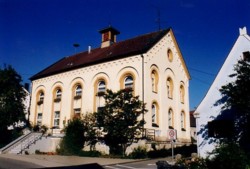Judeo-German (West Yiddish)
Judeo-German :: Language-genetic affiliation
Judeo-German is a cover term for the ethnolectal varieties of German spoken by Jews in rural areas until World War II. Judeo-German has its roots in a more or less uniform variety of medieval German that was acquired by Jews in the Rhine area, and then spread and was subsequently maintained in dispersed communities as far apart as Hamburg, Prague, and Alexandria in Egypt (see page on Yiddish). This variety had its distinct phonology, and was also characterised by the integration of some Hebrew-derived lexicon. It is not entirely clear whether, and if so where and how, older varieties of Judeo-German survived in German-speaking territory after the expulsion of Jews from the twelfth century onwards, or whether they were 'brought back' by Jews who moved westwards from central Europe, and re-established themselves as the western varieties of the language which in the meantime became known in eastern Europe as 'Yiddish' - i.e. West Yiddish, as Judeo-German is referred to by some scholars. It is clear that speakers of Judeo-German in modern times did not refer to their language as 'Yiddish', but regarded it as a variety of German.

Judeo-German :: Historical distribution
Early Judeo-German was used by Jews in Germany and neighbouring regions, as well as in more remote diaspora communities. Its earliest attestation includes private correspondence of Jews in larger cities such as Hamburg. With growing social integration following the political emancipation in the nineteenth century, urban Jews gradually adopted the speech of the urban middle classes, and emigration from rural areas into the cities led to a decline in the use of Judeo-German vernaculars. From the little documentation that exists from rural Jewish communities that continued to flourish in the early twentieth century, it appears that, motivated by frequent mobility for the sake of trade, education and maintaining extended family relations, local Jews in the villages had adopted a mixture of the older Judeo-German ethnolect and the regional vernacular of the middle classes of nearby towns. Since rural Jewish communities in Germany were completely destroyed through deportation or exile during World War II, documentation of the remnants of Judeo-German is very rare indeed. The varieties are now as good as extinct, as there is only a handful of elderly survivors who still remember them, but usually lack the opportunity to speak them.
Judeo-German :: Structural features
Modern Judeo-German varieties had already undergone considerable adaptation to the respective regional vernaculars and are therefore not uniform, though they remained distinct from the local dialects of non-Jewish farmers and as such they constituted 'ethnolects'. A recurring feature in the Judeo-German dialects of the southwestern German-speaking area is the monophthong in kaafen 'to buy', which is generally found farther to the north, in the Franconian speaking areas, but not in the local dialects of the Black Forest, Alsace or Swabian Alps, and the diphthong in dou 'there', equally a Franconian feature. Occasional Hebrew-derived items are used, though they are largely confined to religious and cultural terms, or to an imitation of the Jewish trade language (see Lekoudesch) in anecdotes.
Judeo-German :: References to Yaron Matras's work
- 1997. Zur stilistischen Funktion der Sondersprache Lekoudesch in südwestdeutschen Erzählungen. [The stylistic function of the special language Lekoudesch in narratives in southwest German dialect] In: Löffelad, Peter, & Ruoff, Arno (eds.) Syntax und Stilistik der Alltagssprache. Tübingen: Niemeyer. (Idiomatica 18). 97-106.
- 1991. Zur Rekonstruktion des jüdisch-deutschen Wortschatzes in den Mundarten ehemaliger "Judendörfer" in Südwestdeutschland. Zeitschrift für Dialektologie und Linguistik 58:3, 267-293.